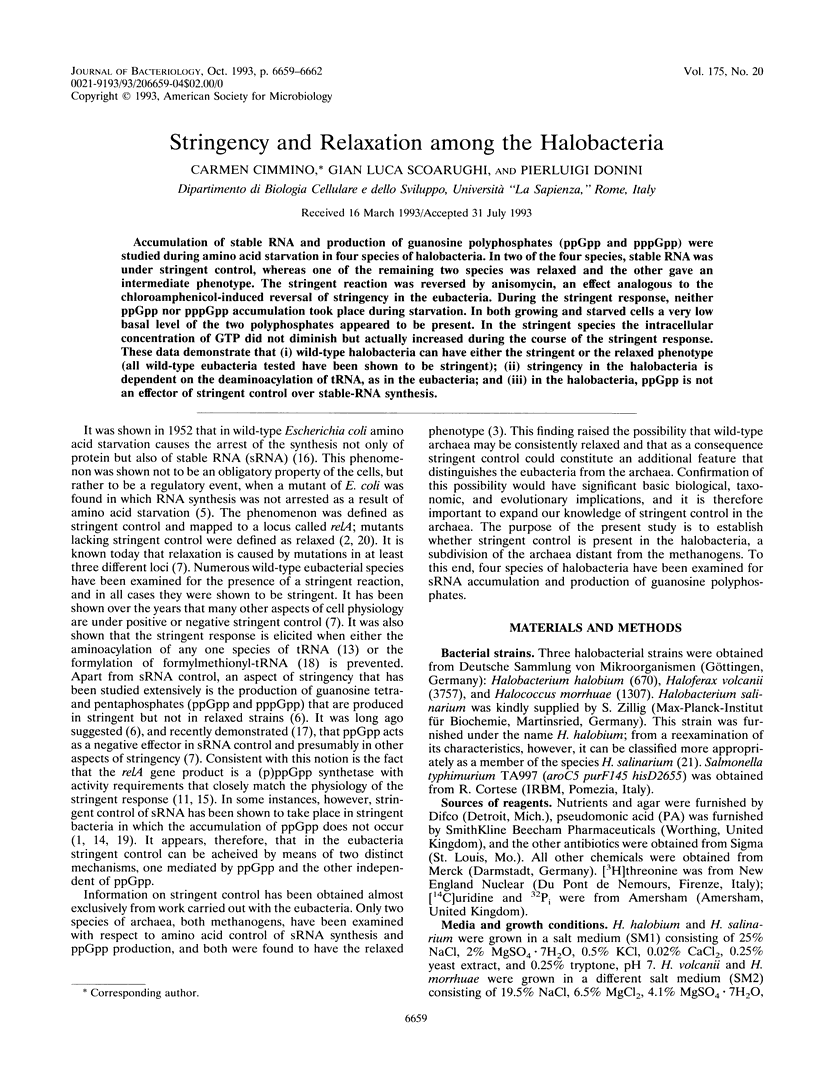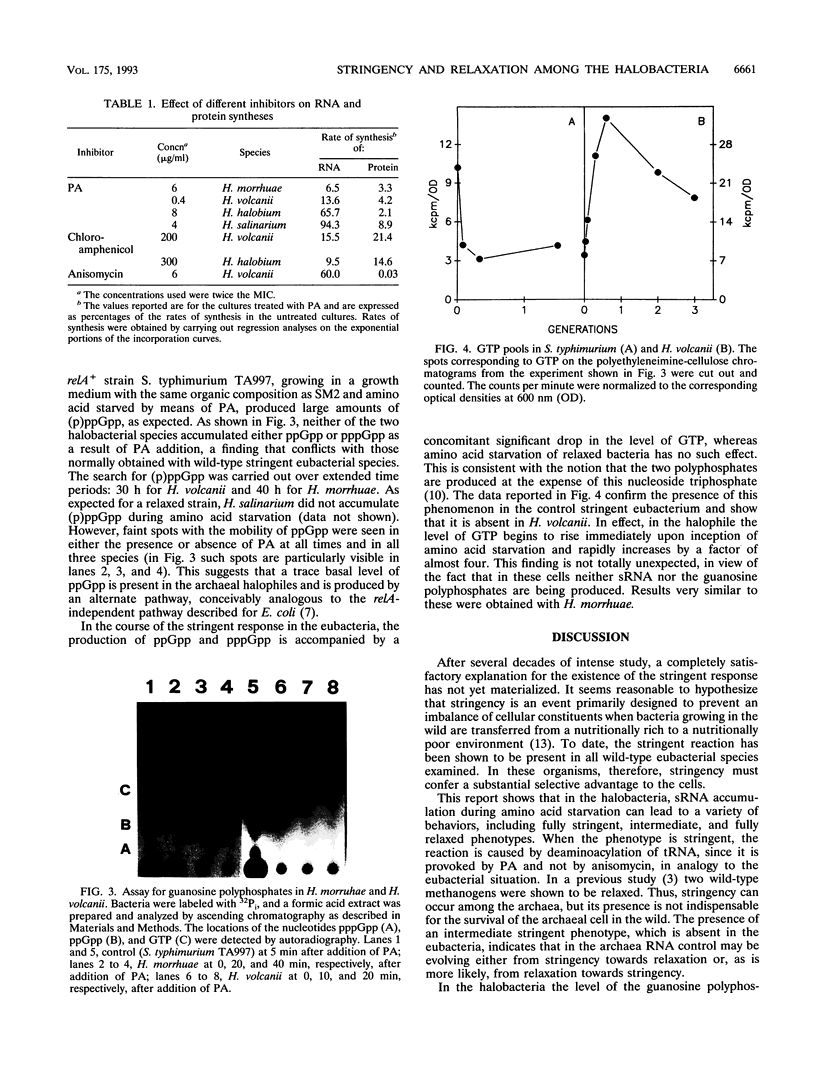Abstract
Accumulation of stable RNA and production of guanosine polyphosphates (ppGpp and pppGpp) were studied during amino acid starvation in four species of halobacteria. In two of the four species, stable RNA was under stringent control, whereas one of the remaining two species was relaxed and the other gave an intermediate phenotype. The stringent reaction was reversed by anisomycin, an effect analogous to the chloroamphenicol-induced reversal of stringency in the eubacteria. During the stringent response, neither ppGpp nor pppGpp accumulation took place during starvation. In both growing and starved cells a very low basal level of the two polyphosphates appeared to be present. In the stringent species the intracellular concentration of GTP did not diminish but actually increased during the course of the stringent response. These data demonstrate that (i) wild-type halobacteria can have either the stringent or the relaxed phenotype (all wild-type eubacteria tested have been shown to be stringent); (ii) stringency in the halobacteria is dependent on the deaminoacylation of tRNA, as in the eubacteria; and (iii) in the halobacteria, ppGpp is not an effector of stringent control over stable-RNA synthesis.
Full text
PDF



Images in this article
Selected References
These references are in PubMed. This may not be the complete list of references from this article.
- ALFOLDI L., STENT G. S., CLOWES R. C. The chromosomal site of the RNA control (RC) locus in Escherichia coli. J Mol Biol. 1962 Sep;5:348–355. doi: 10.1016/s0022-2836(62)80077-1. [DOI] [PubMed] [Google Scholar]
- Acosta R., Lueking D. R. Stringency in the absence of ppGpp accumulation in Rhodobacter sphaeroides. J Bacteriol. 1987 Feb;169(2):908–912. doi: 10.1128/jb.169.2.908-912.1987. [DOI] [PMC free article] [PubMed] [Google Scholar]
- BOREK E., ROCKENBACH J., RYAN A. Studies on a mutant of Escherichia coli with unbalanced ribonucleic acid synthesis. J Bacteriol. 1956 Mar;71(3):318–323. doi: 10.1128/jb.71.3.318-323.1956. [DOI] [PMC free article] [PubMed] [Google Scholar]
- Beauclerk A. A., Hummel H., Holmes D. J., Böck A., Cundliffe E. Studies of the GTPase domain of archaebacterial ribosomes. Eur J Biochem. 1985 Sep 2;151(2):245–255. doi: 10.1111/j.1432-1033.1985.tb09095.x. [DOI] [PubMed] [Google Scholar]
- Cashel M., Gallant J. Two compounds implicated in the function of the RC gene of Escherichia coli. Nature. 1969 Mar 1;221(5183):838–841. doi: 10.1038/221838a0. [DOI] [PubMed] [Google Scholar]
- Donini P. Amino acid control over deoxyribonucleic acid synthesis in Escherichia coli infected with T-even bacteriophage. J Bacteriol. 1970 Jun;102(3):616–627. doi: 10.1128/jb.102.3.616-627.1970. [DOI] [PMC free article] [PubMed] [Google Scholar]
- Gallant J., Harada B. The control of ribonucleic acid synthesis in Escherichia coli. 3. The functional relationship between purine ribonucleoside triphosphate pool sizes and the rate of ribonucleic acid accumulation. J Biol Chem. 1969 Jun 25;244(12):3125–3132. [PubMed] [Google Scholar]
- Haseltine W. A., Block R. Synthesis of guanosine tetra- and pentaphosphate requires the presence of a codon-specific, uncharged transfer ribonucleic acid in the acceptor site of ribosomes. Proc Natl Acad Sci U S A. 1973 May;70(5):1564–1568. doi: 10.1073/pnas.70.5.1564. [DOI] [PMC free article] [PubMed] [Google Scholar]
- NEIDHARDT F. C. Properties of a bacterial mutant lacking amino acid control of RNA synthesis. Biochim Biophys Acta. 1963 Mar 26;68:365–379. doi: 10.1016/0006-3002(63)90158-6. [DOI] [PubMed] [Google Scholar]
- Pao C. C., Dyess B. T. Stringent control of RNA synthesis in the absence of guanosine 5'-diphosphate-3'-diphosphate. J Biol Chem. 1981 Mar 10;256(5):2252–2257. [PubMed] [Google Scholar]
- Pedersen F. S., Lund E., Kjeldgaard N. O. Codon specific, tRNA dependent in vitro synthesis of ppGpp and pppGpp. Nat New Biol. 1973 May 2;243(122):13–15. [PubMed] [Google Scholar]
- SANDS M. K., ROBERTS R. B. The effects of a tryptophan-histidine deficiency in a mutant of Escherichia coli. J Bacteriol. 1952 Apr;63(4):505–511. doi: 10.1128/jb.63.4.505-511.1952. [DOI] [PMC free article] [PubMed] [Google Scholar]
- STENT G. S., BRENNER S. A genetic locus for the regulation of ribonucleic acid synthesis. Proc Natl Acad Sci U S A. 1961 Dec 15;47:2005–2014. doi: 10.1073/pnas.47.12.2005. [DOI] [PMC free article] [PubMed] [Google Scholar]
- Schreiber G., Metzger S., Aizenman E., Roza S., Cashel M., Glaser G. Overexpression of the relA gene in Escherichia coli. J Biol Chem. 1991 Feb 25;266(6):3760–3767. [PubMed] [Google Scholar]
- Shih A. Y., Eisenstadt J., Lengyel P. On the relation between ribonucleic acid synthesis and peptide chain initiation in E. coli. Proc Natl Acad Sci U S A. 1966 Nov;56(5):1599–1605. doi: 10.1073/pnas.56.5.1599. [DOI] [PMC free article] [PubMed] [Google Scholar]
- Spadaro A., Spena A., Santonastaso V., Conini P. Stringency without ppGpp accumulation. Nature. 1981 May 21;291(5812):256–258. doi: 10.1038/291256a0. [DOI] [PubMed] [Google Scholar]
- WISSEMAN C. L., Jr, SMADEL J. E., HAHN F. E., HOPPS H. E. Mode of action of chloramphenicol. I. Action of chloramphenicol on assimilation of ammonia and on synthesis of proteins and nucleic acids in Escherichia coli. J Bacteriol. 1954 Jun;67(6):662–673. doi: 10.1128/jb.67.6.662-673.1954. [DOI] [PMC free article] [PubMed] [Google Scholar]



